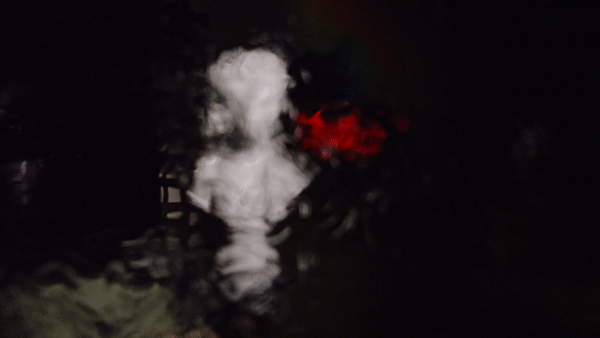

MIRAGE
Isopropyl + Water
Mirage causes the image to distort wildly and return back to clear. A turbulence will encroach on center frame and eventually become invisible.
Every camera/lens combination produces its own unique effect.
Mirage can be consistently and predictably repeated if spun slow and continuously. In the Black and White images below the follow focus unit was set to calibrate. This causes a swirling effect that starts form edges of frame and gradually works its way to the center!
Note: Mirage is a tricky effect to achieve. Each time Mirage is activated the effect will have less strength due to the isopropyl and water mixing. KineticGlass will have to be reset if high strength is desired. Read more about working with Mirage below.
For a more subtle effect the mixture must be agitated several times until the result is acceptable.
The color profile can be altered by coloring the water and or isopropyl. SET and RISE are in the same class but use colors.




The Clip above showcases Mirage going through its entire cycle. That means the filter is activated during the take and spun until the effect has dissipated. Notice how the image begins and ends clear!
This scene is from an upcoming Film "They Don't Make Guys Like Me No More"
Starring Fred Darby
Director: Mike Laudi
Cinematographer: Khan
Producer: Maxx Brawer
Cabrio 19-90
T16/22
Above is an example of SunSET which includes red water.
Coloring one or both of the fluids within KineticGlass will cause the color profile to shift.
Panavision ULTRA SPEED 14mm
T11/16

Each time Mirage is activated the effect is less pronounced. If a softer effect is desired, the solution must be agitated until the look is achieved. The examples below show high strength Mirage (First Activation) and a lower strength Mirage (Seventh Activation).
High Strength Mirage
Low Strength Mirage

Depth of field plays a major role in the effect. A larger depth of field means more prominent distortion.
A wider lens or stopping down will cause the distortion to be more pronounced.
The video below demonstrates Mirage shot at different apertures.
Working with Mirage
A: Isopropyl
B: Water
Mirage is a tricky effect to use. It is important to note that there are several steps involved when working with Mirage. These steps can be time consuming and must be considered. Depending on the desired strength it can be activated a couple times until it must be reset.
Mirage must be prepared the day prior or just before a take. Having multiple units on standby allows for the ability to swap and shoot the next take immediately while the other units are reset.
Aperture and focal length plays a major role. The distortion is more pronounced closed down and or at wider focal lengths. The image will become hazy at wider aperture or tighter focal length. Essentially, greater depth of field equates to more distortion.
There are dozens of ways Mirage can be activated, and each method produces a different outcome. Spin type in conjunction with altering the ratio of water to isopropyl means there are hundreds of possibilities. Factors include, the ratio of water to isopropyl, the direction the filter is spun (clockwise/counterclockwise), the speed the filter is spun, the angle the filter stops, how fast the filter stops, etc.
Further agitating Mirage once it has been activated will cause the effect to dissipate much faster.
Creating Mirage:
It is useful to have a container available to empty the contents.
Have isopropyl and water available.
Step 1: Begin with an empty unit.
Step 2: Fill KG with the desired amount of water.
Using bottled or distilled water will lower the chances of bubbles developing.
Step 3: Gently fill the remaining space with isopropyl.
Step 4: Insert the screw to seal off the unit.
NOTE: Mirage is now ready to go! It is vital to keep the unit upright to avoid activation before the take. A little movement and tilting is fine but do be aware that it should not be agitated too much until the take.
TIPS:
Practice with mirage. Familiarize yourself with refilling mirage. Test out the effect on a desired lens to make sure you will be getting the anticipated outcome. As mentioned above aperture and focal length play a major role in the effect. Higher apertures and or wider lenses will cause distortion while lower apertures and or tighter lenses will cause blurring.
Bubbles
If bubbles are present, lightly tap the unit to get the air to the top of the unit. Top off the unit with isopropyl to remove the bubble.
Control
Mirage can be consistently and predictably repeated if spun slow and continuously. In the Black and White images above the follow focus unit was set to calibrate. This causes a swirling effect that starts form edges of frame and gradually works its way to the center!
Mapping the Follow Focus unit so that one rotation of the knob is one full rotation of KineticGlass makes it easy to keep track of the orientation of KineticGlass. Rotating the unit one half turn will activate Mirage.
Different ratios of water and isopropyl will change the outcome. There will be a visible separation line between the isopropyl and water. The separation line can be erased by flipping the unit 180 degrees. Additionally this line can be placed out of frame by using less or more water. The separation will fade overtime, and will be invisible after sitting for several hours.
Note: Do not store Mirage for extended periods of time as this can cause mold. Fill the unit with isopropyl entirely once finished, or rinse with isopropyl and store empty.
Submit examples using KineticGlass Mirage to have them featured here!

Citations
Clip 1
Zulia - Cinetosis (Video Oficial)
Director: David Herrera
DP: Adriel Gonzalez
Clip 3
RENACER - Coming soon
Director: Jenn Gonzalez-Martinez
DP: Meg Weck










